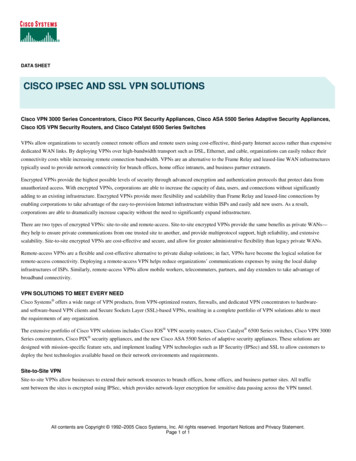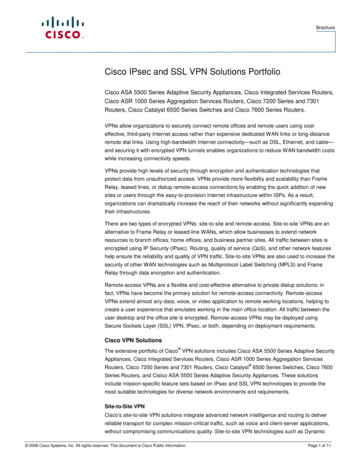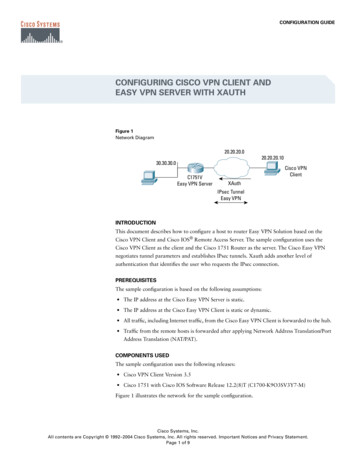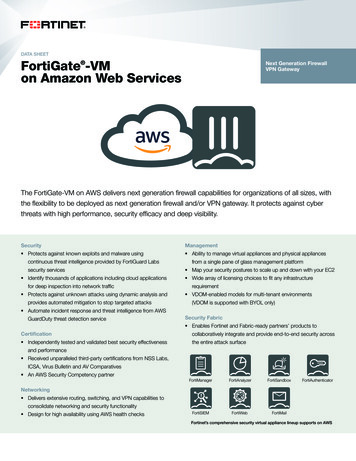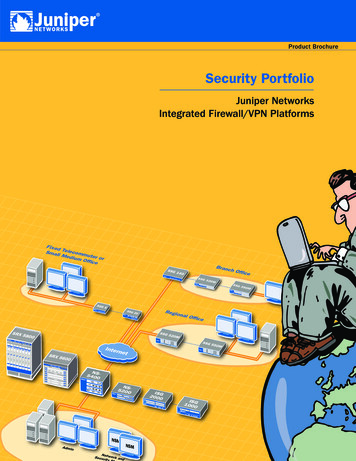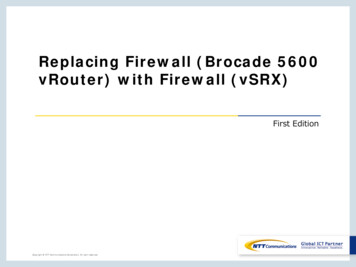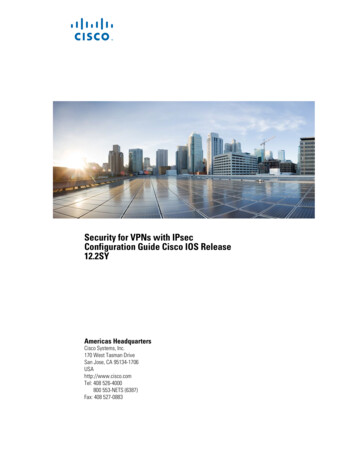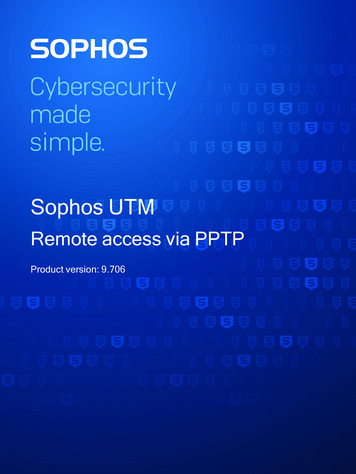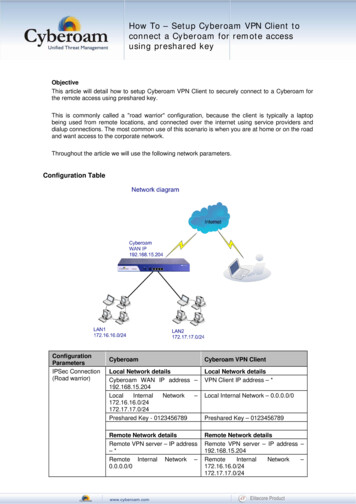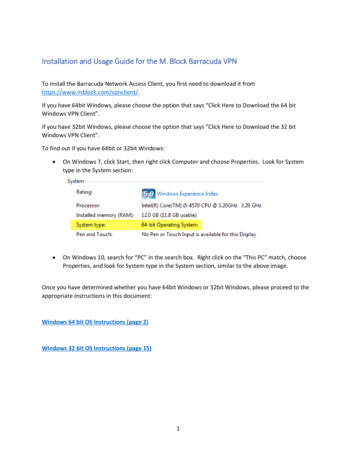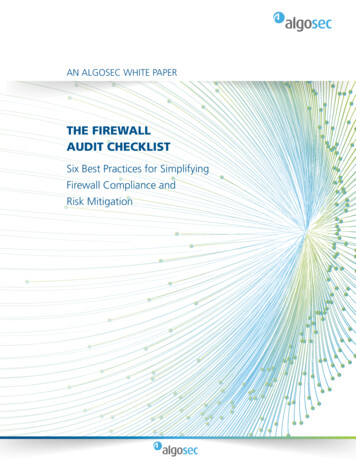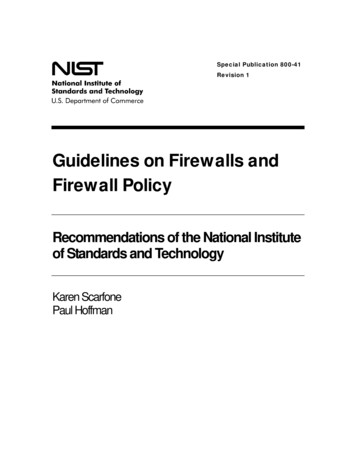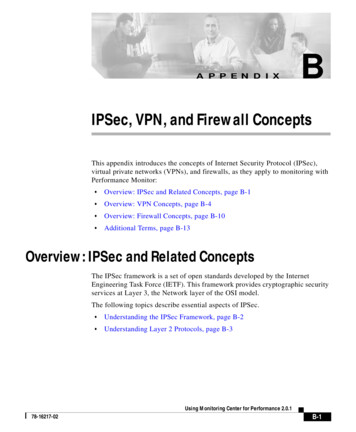
Transcription
A P P E N D I XBIPSec, VPN, and Firewall ConceptsThis appendix introduces the concepts of Internet Security Protocol (IPSec),virtual private networks (VPNs), and firewalls, as they apply to monitoring withPerformance Monitor: Overview: IPSec and Related Concepts, page B-1 Overview: VPN Concepts, page B-4 Overview: Firewall Concepts, page B-10 Additional Terms, page B-13Overview: IPSec and Related ConceptsThe IPSec framework is a set of open standards developed by the InternetEngineering Task Force (IETF). This framework provides cryptographic securityservices at Layer 3, the Network layer of the OSI model.The following topics describe essential aspects of IPSec. Understanding the IPSec Framework, page B-2 Understanding Layer 2 Protocols, page B-3Using Monitoring Center for Performance 2.0.178-16217-02B-1
Appendix BIPSec, VPN, and Firewall ConceptsOverview: IPSec and Related ConceptsUnderstanding the IPSec FrameworkThe IPSec framework provides these essential features for secure communication: Peer authentication Data confidentiality Data integrity Data origin authenticationThe IPSec framework facilitates these features with two types of tunnels: Key management tunnels—also known as Phase-1 (IKE) tunnels. Data management tunnels—also known as Phase-2 (IPSec) tunnels.Key management tunnels and data management tunnels both require securityassociations.Using Monitoring Center for Performance 2.0.1B-278-16217-02
Appendix BIPSec, VPN, and Firewall ConceptsOverview: IPSec and Related ConceptsUnderstanding Layer 2 ProtocolsThere are three types of Layer 2 protocols: PPTP, L2F, and L2TP.Table B-1Layer 2 ProtocolsProtocolDescriptionL2FLayer 2 Forwarding (L2F) creates Network Access Server (NAS)-initiated tunnels byforwarding Point-to-Point (PPP) sessions from one endpoint to another across a sharednetwork infrastructure.Cisco Systems developed the L2F protocol.L2TPLayer 2 Tunneling Protocol (L2TP) is an IETF standard tunneling protocol that tunnelsPPP traffic over LANs or public networks.L2TP was developed to address the limitations of IPSec for client-to-gateway andgateway-to-gateway configuration, without limiting multivendor interoperability.An extension of PPP, L2TP is based on L2F and PPTP.PPTPPoint-to-Point Tunneling Protocol (PPTP) is not a standard tunneling protocol. Microsoftdeveloped PPTP, which—like L2TP—tunnels Layer 2 PPP traffic over LANs or publicnetworks.PPTP creates client-initiated tunnels by encapsulating packets into IP datagrams fortransmission over the Internet or other TCP/IP-based networks.Using Monitoring Center for Performance 2.0.178-16217-02B-3
Appendix BIPSec, VPN, and Firewall ConceptsOverview: VPN ConceptsOverview: VPN ConceptsA virtual private network (VPN) is a framework that consists of multiple remotepeers transmitting private data securely to one another over an otherwise publicinfrastructure (generally a shared IP backbone), such as the Internet. In thisframework, inbound and outbound network traffic is protected by using tunnelsthat encrypt all data at the IP level. The framework permits networks to extendbeyond their local topologies while providing remote users with the appearanceand features of a direct network connection.Typically, remote peers (sites and users) are connected to the central site over ashared infrastructure in a hub-and-spoke topology, although it is possible toconfigure remote access VPNs in two other ways. These other configurations arecalled “full mesh” and “partial mesh.” Performance Monitor supports all of theseVPN types.Key Terms and Acronyms in VPN TechnologiesThese terms and acronyms might help you improve your understanding of generalVPN technologies.AcronymTermDefinition3DESTriple Data Encryption Standard A data encryption standard that applies three 56-bitprivate keys in succession to 64-byte blocks of data. USonly.AHAuthentication HeaderA component of IPSec packets that provides basic dataauthentication.CACertification AuthorityAn agency that provides digital certificates that itsclients can use to establish or prove their identity topeers and secure their communications.CBCCipher Block ChainingA cryptographic mode that provides data encryptionand authentication using AH and ESP.DESData Encryption StandardA standard method of data encryption that applies56-bit private keys to 64-byte blocks of data.DHDiffie-Hellman Key ExchangeA protocol that enables two devices to exchange keyssecurely over an insecure medium.Using Monitoring Center for Performance 2.0.1B-478-16217-02
Appendix BIPSec, VPN, and Firewall ConceptsOverview: VPN ConceptsAcronymTermDefinitionESPEncapsulating Security Protocol A protocol that provides tunneling services forencryption and/or authentication.HMACHashed Message Authentication A technique that provides message authentication usingCodehashes for encryption.IETFInternet Engineering Task Force Task force responsible for developing Internetstandards.IKEInternet Key ExchangeA control protocol that negotiates, establishes,maintains, and tears down IPSec connections.IPSecIP Security ProtocolA framework of open standards that provides dataconfidentiality, data integrity, and data originauthentication between peers that are connected overunprotected networks such as the Internet. IPSecprovides security services at the IP layer and can beused to protect one or more data flows between a pair ofhosts, between a pair of security gateways, or betweena security gateway and a host. IPSec acts at the networklayer to protect and authenticate IP packets, whileoffering three methods of authentication: presharedkeys, digital certificates, and RSA encrypted nonces.ISAKMPInternet Security Associationand Key Management ProtocolA generic protocol that enables two devices to exchangesecurity parameters.L2FLayer 2 ForwardingA tunneling protocol that creates network access server(NAS)-initiated tunnels for forwarding PPP sessions.L2TPLayer 2 Tunneling ProtocolAn IETF standard tunneling protocol for VPNs,designed to tunnel PPP traffic over LANs or publicnetworks.LACL2TP Access ConcentratorDevice terminating calls to remote systems andtunneling PPP sessions between remote systems and theLNS.LNSL2TP Network ServerDevice able to terminate L2TP tunnels from a LAC andterminate PPP sessions to remote systems throughL2TP data sessions.MACMessage Authentication CodeThe cryptographic checksum of the message used toverify its (the message’s) authenticity.Using Monitoring Center for Performance 2.0.178-16217-02B-5
Appendix BIPSec, VPN, and Firewall ConceptsOverview: VPN ConceptsAcronymTermDefinitionMD5Message Digest 5The result of a computation that provides basic messageauthentication.NASNetwork Access ServerGateway that connects asynchronous devices to a LANor WAN through network and terminal emulationsoftware. Performs both synchronous andasynchronous routing of supported protocols.PACPPTP Access ConcentratorDevice terminating calls to remote systems andtunnelling PPP sessions between remote systems andthe PNS.PNSPPTP Network ServerDevice able to terminate PPTP tunnels from a PAC andterminate PPP sessions to remote systems throughPPTP data sessions.PPPPoint-to-Point ProtocolA protocol that tunnels multiple network-layerprotocols.PPTPPoint-to-Point TunnelingProtocolA Microsoft protocol for Layer 2 that serves the samepurpose as L2TP.PSTNPublic Switched TelephoneNetworkAny of a variety of telephone networks and services inplace worldwide. Also called Plain Old TelephoneSystem (POTS).SASecurity AssociationA set of security parameters that defines a particulartunnel. Key management tunnels employ one SA, whiledata management tunnels employ at least two.SHASecure Hash AlgorithmAn algorithm that provides strong messageauthentication.SPISecurity Parameter IndexA number that, together with a destination IP addressand security protocol, uniquely identifies a particularsecurity association.VPNVirtual Private NetworkA secure communication channel that provides thesame network connectivity for remote users over apublic infrastructure as they would have locally in aprivate network.Using Monitoring Center for Performance 2.0.1B-678-16217-02
Appendix BIPSec, VPN, and Firewall ConceptsOverview: VPN ConceptsUnderstanding Types of VPNsA VPN provides the same network connectivity for remote users over a publicinfrastructure as they would have over a private network. VPN services fornetwork connectivity consist of authentication, data integrity, and encryption.The two basic VPN types are remote access and site-to-site. See Table B-2.Table B-2Basic VPN TypesVPN TypeDescriptionRemote AccessRemote access VPNs secure connections for remote users, such as mobileusers or telecommuters, to corporate LANs over shared service providernetworks.There are two types of remote access VPNs:Site-to-Site Client-Initiated. Remote users use clients to establish a secure tunnelthrough a shared network to the enterprise. NAS-Initiated. Remote users dial in to an ISP Network Access Server(NAS). The NAS establishes a secure tunnel to the enterprise privatenetwork that might support multiple remote user-initiated sessions.The two common types of site-to-site VPNs (also known as LAN-to-LANVPNs) are intranet and extranet. Intranet VPNs connect corporateheadquarters, remote offices, and branch offices over a publicinfrastructure. Extranet VPNs link customers, suppliers, partners, orcommunities of interest to a corporate intranet over a public infrastructure.Using Monitoring Center for Performance 2.0.178-16217-02B-7
Appendix BIPSec, VPN, and Firewall ConceptsOverview: VPN ConceptsUnderstanding VPN ComponentsThe three main components of VPNs are tunnels, endpoints, and sessions. SeeTable B-3.Table B-3Primary VPN ComponentsComponentDescriptionTunnelsVirtual channels through a shared medium. They provide a securecommunications path (an encapsulated traffic flow) between two peers.Every VPN tunnel can consist of multiple sessions.EndpointsA network device on which a tunnel ends. The following devices can serveas endpoints: a computer running a VPN client, a router, a gateway, or anetwork access server. The two ends of a tunnel are commonly called thesource and the destination endpoints.Sessions A source endpoint initiates the tunnel. A destination endpoint terminates the tunnel.Portions of tunnels that pertain to the transmission of a specific user in asingle, tunneled PPP call between two peers.A remote access tunnel can contain one or more PPP connections. Eachconnection represents one user. However, Performance Monitor refers toany user connection to a device as a session.Using Monitoring Center for Performance 2.0.1B-878-16217-02
Appendix BIPSec, VPN, and Firewall ConceptsOverview: VPN ConceptsUnderstanding VPN ServicesVPNs provide four types of services: peer authentication, data confidentiality,data integrity, and data origin authentication.Table B-4Services that VPNs ProvideServiceDescriptionPeer authenticationEndpoints verify each other’s identity before establishing a VPN tunnel.Data confidentialityEndpoints use encryption to prevent the unauthorized viewing oftransmitted packets.Data integrityDestination endpoint confirms that packets received from the sourceendpoint are identical to the packets that were transmitted.Data origin authentication Destination endpoint confirms that received data originated from thesource endpoint.Understanding VPN TunnelsThe following topics explain the function and structure of VPN tunnels. Understanding Key Management Tunnels, page B-9 Understanding Data Management Tunnels, page B-10 Understanding Security Associations, page B-10Understanding Key Management TunnelsKey management tunnels (also called Phase-1 or IKE tunnels) set up and maintaindata management tunnels. Key management tunnels use the IKE protocol toperform their functions. The IKE protocol authenticates the peer and thennegotiates a compatible security policy before establishing the data tunnel.The key management tunnel facilitates: IPSec Key Negotiation. IPSec Key Renegotiation. The exchange of control messages for maintaining data management tunnels.Using Monitoring Center for Performance 2.0.178-16217-02B-9
Appendix BIPSec, VPN, and Firewall ConceptsOverview: Firewall ConceptsUnderstanding Data Management TunnelsData management tunnels (also called Phase-2 or IPSec tunnels) secure datatraffic. Data management tunnels use the Authentication Header (AH) protocoland the Encapsulated Security Protocol (ESP) to perform their operations.Data management tunnels facilitate: Data integrity. Data confidentiality.Data management tunnels can be set up automatically by using key managementtunnels or manually by operators.The two modes of operation for a data management tunnel are: Tunnel mode, in which the tunnel protects both the data and the identities ofthe endpoints. Transport mode, in which the tunnel protects only the data.Understanding Security AssociationsA security association (SA) is a set of security parameters for authentication andencryption used by a tunnel. Key management tunnels use one SA for bothdirections of traffic; data management tunnels use at least one SA for eachdirection of traffic. Each endpoint assigns a unique identifier, called a securityparameter index (SPI), to each SA.Overview: Firewall ConceptsA firewall is a router, an access server, or a service module (or several suchdevices), designated as a buffer between any connected public networks and aprivate network. A firewall uses access lists and other methods to ensure thesecurity of the private network.Performance Monitor monitors firewall services that originate on either of twodifferent kinds of Cisco devices: PIX 500 Series Firewalls, page B-11 Firewall Service Modules, page B-11Using Monitoring Center for Performance 2.0.1B-1078-16217-02
Appendix BIPSec, VPN, and Firewall ConceptsOverview: Firewall ConceptsPIX 500 Series FirewallsPIX 500 Series Firewalls are Cisco appliances that use the PIX OS to provide: AAA (RADIUS/TACACS ). Content (Java/ActiveX) filtering and URL filtering. DHCP client/server. Intrusion protection. Network Address Translation (NAT) and Port Address Translation (PAT). Point-to-point protocol over Ethernet (PPPoE) support. Standards-based IPsec VPN. Stateful inspection firewalling. X.509 PKI support.PIX Firewalls also provide security services for multimedia applications andprotocols including Voice over IP (VoIP), H.323, SIP, Skinny Client ControlProtocol (which is a Cisco-developed replacement for the H.323 protocol), andMicrosoft NetMeeting.Firewall Service ModulesA firewall service module is a multigigabit, fabric-enabled module forCisco Catalyst 6500 switches and Cisco 7600 Series routers. It is deployed at theenterprise campus edge and at distribution points.NotePerformance Monitor monitors firewall service modules only when they areinstalled in a Catalyst 6500 switch. Routers in the Cisco 7600 Series are notsupported in this Performance Monitor release. See Supported Devices andSoftware Versions for Monitoring Center for Performance 2.0.Using Monitoring Center for Performance 2.0.178-16217-02B-11
Appendix BIPSec, VPN, and Firewall ConceptsOverview: Firewall ConceptsA firewall service module has no external ports. Instead, it allows any port on aCatalyst 6500 chassis to operate as a firewall port. It uses the Cisco PIX operatingsystem to provide: High-performance (5 Gbps), full-duplex firewall functionality. 3M pps throughput. Support for 100 VLANs. 1M concurrent connections (setup rate of 100,000 connections per second). LAN failover: active/standby, inter/intra chassis. Dynamic routing with OSPF/RIP. Up to 4 modules per chassis (scalable to 20 GB per chassis). Cut-through proxies enforce security policies per VLAN. The complete feature set of Cisco PIX 6.0 software and these features of theCisco PIX 6.2 software:– Command authorization.– Object grouping.– ILS/NetMapping fixup.– URL filtering enhancement.Using Monitoring Center for Performance 2.0.1B-1278-16217-02
Appendix BIPSec, VPN, and Firewall ConceptsAdditional TermsAdditional TermsFamiliarity with these terms will help you to understand the Performance Monitorapplication and its associated technologies.TermDefinitionalarmAn alarm signifies abnormal operation in a service, a network entity, or a part of anetwork entity.alertAlarm (audible or visual) that signals an error or serves as a warning.authenticationIn a VPN, the verification of peer identity using any combination of deviceauthentication, data origin authentication, extended authentication, and dataintegrity checking.In the context of AAA, entity authentication is the method of verifying user ID,including login and password, challenge and response, messaging support,and—depending on the security protocol that is selected—encryption.authenticationmethodOne of several procedures for verifying the identity of a peer, such as a challengepassword or a digital certificate.community stringText string that authenticates the issuer of an SNMP query.CSV file(Comma-SeparatedValue)A common text file format that contains comma-delimited values. In the case ofPerformance Monitor, these values describe devices and their attributes.deviceIn Performance Monitor, a device is either a physical node in the network or it is avirtual node that is defined by a physical node. In either case, whether physical orvirtual, a device must be IP-addressable.device hierarchyLevels in which devices are grouped in an Object Selector. All devices arecategorized into groups.eventAn event is a notification that a managed device or component has an abnormalcondition. Multiple events can occur simultaneously on a single monitored deviceor service module. To display events, you open an Event Browser.event loggingA mechanism by which events are archived and collected for viewing.firewallA device that provides firewall services. In Performance Monitor, a firewall is aPIX firewall appliance or a firewall service module for a Catalyst Series switch.Using Monitoring Center for Performance 2.0.178-16217-02B-13
Appendix BIPSec, VPN, and Firewall ConceptsAdditional TermsTermDefinitiongroupA device group in Performance Monitor is a collection of devices (or groups ofdevices) that is the equivalent of a folder, offering an organizational convenience.Some groups are system-defined and others are user-defined. Among the devices ina user-defined group, no physical, logical, or topological relationship is assumedunless you organize devices in a consistent way. In a broader sense, a group is anycollection of network objects, devices, users, or other entities for which rules canbe defined.importing devicesImporting is a mechanism by which you transfer a descriptive list of deviceattributes from an outside inventory to Performance Monitor. Supported importsources are Resource Manager Essentials (RME), Management Center for VPNRouters (Router MC), or a comma-separated value (CSV) file.inboundTraffic that a device receives through its interfaces.interfaceA physical or logical subcomponent through which a device can connect to otherdevices.IPSec tunnelAn IPSec tunnel is a tunnel established between two peers and secured with IPSecprotocols.LAN-to-LAN VPNSee site-to-site VPN.load balancingA mechanism that distributes incoming service requests evenly among servers inthe back end, such that the load distribution is transparent to users.outboundTraffic that a device transmits through its interfaces.SNMP(Simple NetworkManagementProtocol)Network management protocol used almost exclusively in TCP/IP networks.SNMP provides a means to monitor and control network devices, and to manageconfigurations, statistics collection, performance, and security.SNMP trapA notification event issued by a managed device to the network management stationwhen a significant event (not necessarily an outage, a fault, or a security violation)occurs.SSL(Secure SocketsLayer)Encryption technology for the web used to provide
A VPN provides the same network connectivity for remote users over a public infrastructure as they would have over a private network. VPN services for network connectivity consist of authentication, data integrity, and encryption. The two basic VPN types are remote access and site-to-site. See Table B-2 . Table B-2 Basic VPN Types VPN Type .
